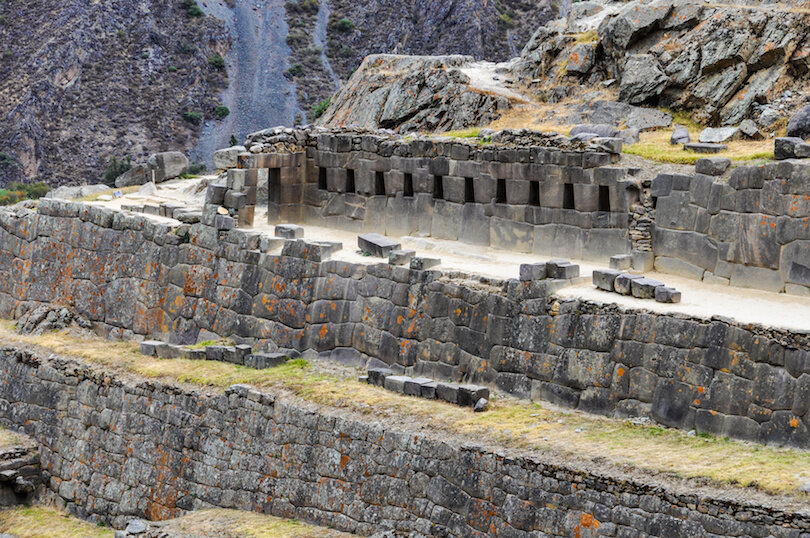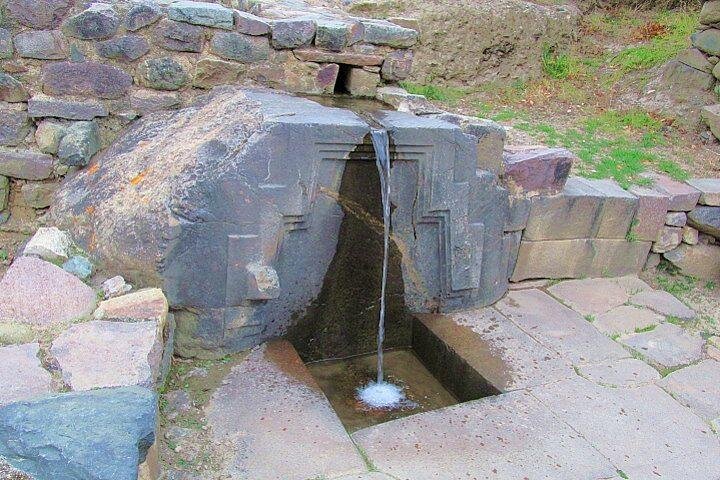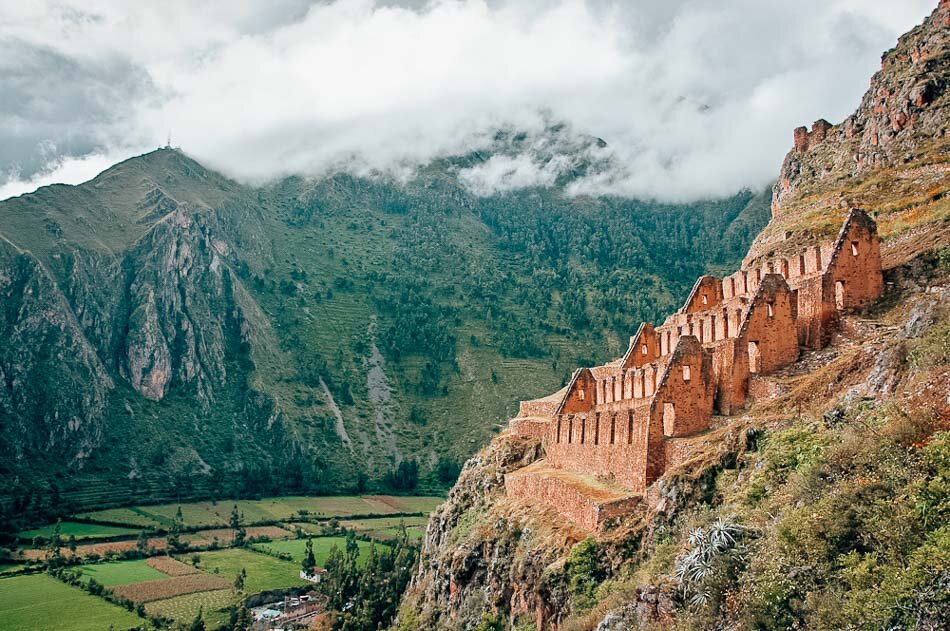Ollantaytambo
On the westernmost side of the famous Sacred Valley of the Incas, a two hour ride from Cusco, lies the old picturesque village of Ollantaytambo (pronounced "oy-yahn-tie-tahm-bo"). Itself situated on an altitude of almost 2800m, it is surrounded by towering mountainsides that hide many mysterious paths, hidden caves and lonely ruins, and lies at the confluence of the Patacancha and the bigger and ever fast flowing Urubamba river, rushing its way to the lower eastern side of the Andes and eventually joining the waters of the Amazon basin. Above the village lies the fortress by the same name: an impressive Inca structure consisting of amazing stone work and built from huge boulders that can be seen from almost anywhere in the village. Construction of the site began during the reign of Pachacutec but was never completed.
Inca stonework at Ollantaytambo
THE LEGEND OF OLLANTAY
Ollantaytambo and its fortress are attributed to the extensive building program of Inca Emporer Pachacutec, the 9th Inca Emperor (1418–1471/1472) who expanded the Inca territory from the Cusco area to a vast empire (though if you have taken a tour with Mike, then you know the word “Empire” doesn’t really apply to the Inca, as they did not have slaves). The town of Ollantaytambo is also linked to the legend of a love story from Inca times, that survived the centuries and gained more popularity in modern times. The story tells of the most trusted general of Inca Pachacutec, who fell in love with the Inca’s daughter, Cusi Coyllur. Because Ollantay was not of royal descent their love affair had to stay secret, but let eventually to the birth of a daughter, Yma Sumac. In one version of the story, Ollantay asked the Inca for the hand of Cusi Coyllur and was refused, but eventually pardoned. In another version, he saved the life of one of the sons of the Inca from a hostile tribe and was given the hand of Cusi Coyllur. Either way, this is the reason the town of Ollantaytambo was named after him.
THE BATTLE OF OLLANTAYTAMBO
Ollantaytambo lies at the junction between the high Andes and the Amazon basin, writes John Hemming in “The Conquest of the Incas”, which makes it a crucial point both geographically and politically. The Incas were highland dwellers and their empire stretched only to the edge of the Andes range. Beyond Ollantaytambo, the slopes of the high Andes descend into the dense and increasingly impenetrable jungle of the Amazon.
When the Spanish invaders conquered Cusco and pushed those loyal to the last Incas further and further back, Ollantaytambo became the last stronghold of the Incas in the Andes before the last of them retreated into the jungle. Before retreating however, Manco Inca and his armies fought a battle against the Spanish expedition led by Hernando Pizarro and trapped the Spaniards on the plains of the valley by retreating onto higher situated terraces and flooding the plain. Even though the Incas famously won this battle (fought between armies of each 30.000 strong!), Manco Inca realised that his position at Ollantaytambo was too vulnerable because of its proximity to Cusco and, and he retreated further north into the jungle.
MYSTERIES: THE FORTRESS
Why was it built? Some assume the area of Ollantaytambo was built as a royal estate for the Inca and his family. However, that does not explain the mysterious fortress on the hillside above town.
The Princess Bath “Baños de la Ñusta”
The Ollantaytambo fortress consist of 17 layers of stone terraces that climb up the hill, topped off by massive walls that enclose - and here the real mystery starts - what seems to have been a temple or ceremonial centre. A climb up the 200 steps to the top gives a visitor a close up look at the remains of several fountains and temples. Those local to the area also like to point out the Inca face carved into the cliff above the valley. The elaborate walled complex contained a temple to the sun, used for astronomical observation, as well as the Baños de la Ñusta (ceremonial baths dedicated to the worship of Unu or Yaku, both water deities), leading archaeologists to believe that Ollantaytambo existed for more than defensive purposes.
However, the terraces and walls, as well as the strategic location, do seem to suggest a defensive purpose. This makes sense, given the position of Ollantaytambo close to Cusco yet at the edge of the Andes and close to the jungle, which was where the Incan empire ended and other tribes ruled. But the parapets and terraced hillsides don’t enclose and actual fort or military post - they surround what is now called the Temple of the Sun and the Temple of the Condor. Why build a religious structure on top of a fortified hill? Above a royal estate?
Besides the function of the ruins, also the structures itself pose unanswerable questions. Some parts of the fortress are built with 40 to 50 ton boulders and, like with other Inca buildings, the stones are carved and fitted together perfectly. The boulders come from quarries across the river, high up a hillside at least 500 m above the Valley: the Cachiccata quarries. Up to the present day you can hike to these quarries and see the jaw dropping size of the boulders that were quarried and left there, or left alongside the path half way to Ollantaytambo, when the Spaniards conquered the area and the quarries were abandoned.
The first quarry can be recognised by the almost eerie little round buildings that are built on the rocks all around the path. They are too small to be entered (except for one or who), and must have housed idols or have been erected for some ceremonial or religious function. The second quarry still consists of enormous rocks and boulders some of which are clearly cut out to some shape, like the huge wheel shaped one that is now hidden between the bushes on the side of the path. A cave nearby houses human remains and is still visited by local people who leave little offerings. That ancestors of today’s population ever moved these stones down the slope of the mountain, across the river, and up the other side to the fortress, is an incredible feat of almost superhuman proportions.
Whatever the function, origin or tale of Ollantaytambo has been, it stands as a monument to human ingenuity and the mysteries that are left to us by people we know so little about. Some other beautiful but mysterious landscape futures around Ollantaytambo: as already mentioned, the Inca face on the mountain above the old town, the two dimensional pyramid that can be seen on the plain of the valley, and the nearby ceremonial cave called Ñaupa Iglesia.
Inca face on the mountain
Inca Astronomy
The Incas were very purposeful in their planning of Ollantaytambo and aligned the constructions to the position of the stars. The Temple of the Sun was most definitely used for Inca astronomy purposes.
The fortress itself consists of seventeen superimposed terraces, built on large stones carved of pink granite, in some cases measuring more than four meters high by two meters wide by two meters deep. The wall on the southeast edge of the Casa Real has an approximate azimuthal direction of 43°. The remains of the structure are not rectangular but adjacent monoliths are oriented at an azimuth of 60°, which is about the direction of sunrise on the June solstice, when it appears over the hill, Pinkuylluna, located directly in front of it. So we can learn from that the Temple of the Sun had a particular purpose on 21st June (winter solstice) and 21 December (summer solstice).
Located to the east of the Temple of the Sun in Ollana Valley lies the Inticcahuarina (or Incamisama). This consists of a large vertical rock surface tiled where some elements could act as seasonal markers. In particular, one of them seems to have indicated the passage of the sun through the zenith during the December solstice, when the festival of Capac Raymi was celebrated.
Moreover, the Easter Island in Chile, the Nazca lines in Peru, Ollantaytambo in Peru, the pyramids of Pantiacolla (the enigmatic pyramids of Paratoari in the Amazon) in Peru, the ancient paintings of Tassili n’Ajjer in the south of Algeria, in the Sahara Desert and the Pyramids of Giza in Egypt, are lined up in a large circle. This alignment within the geodesic lines of the planet is incredibly amazing and gives Ollantaytambo a much greater meaning.
If you have any questions, feel free to contact Mike, he will be happy to answer them!











